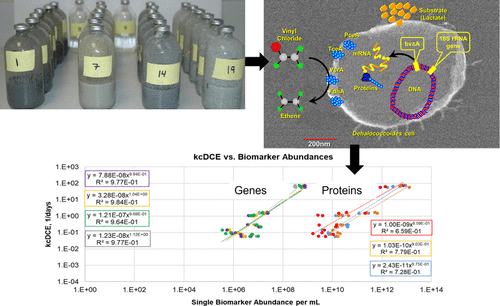当前位置:
X-MOL 学术
›
ACS ES&T Eng.
›
论文详情
Our official English website, www.x-mol.net, welcomes your
feedback! (Note: you will need to create a separate account there.)
Quantitative Proteomics and Quantitative PCR as Predictors of cis-1,2-Dichlorethene and Vinyl Chloride Reductive Dechlorination Rates in Bioaugmented Aquifer Microcosms
ACS ES&T Engineering ( IF 7.4 ) Pub Date : 2021-11-16 , DOI: 10.1021/acsestengg.1c00207 Mandy M. Michalsen 1 , Fadime Kara Murdoch 2, 3 , Frank E. Löffler 3, 4 , John Wilson 5 , Paul B. Hatzinger 6 , Jack D. Istok 7 , Larry Mullins 2 , Amy Hill 2 , Robert W. Murdoch 2 , Charles Condee 6 , Katarzyna H. Kucharzyk 2
ACS ES&T Engineering ( IF 7.4 ) Pub Date : 2021-11-16 , DOI: 10.1021/acsestengg.1c00207 Mandy M. Michalsen 1 , Fadime Kara Murdoch 2, 3 , Frank E. Löffler 3, 4 , John Wilson 5 , Paul B. Hatzinger 6 , Jack D. Istok 7 , Larry Mullins 2 , Amy Hill 2 , Robert W. Murdoch 2 , Charles Condee 6 , Katarzyna H. Kucharzyk 2
Affiliation

|
Quantitative measurement of process-specific biomarker genes of Dehalococcoides mccartyi (Dhc) supports monitoring at chlorinated ethene contaminated sites. In this study, we varied Dhc cell abundances from ∼103 to 108 cells/mL in aquifer microcosms and correlated the corresponding reductive dehalogenase (RDase) gene and RDase protein abundances with measured reductive dechlorination (RD) rates of cis-1,2-dichloroethene (cDCE) and vinyl chloride (VC). An additional set of microcosms tested the RD rate-predictive power of the regression analyses. These efforts revealed (1) that targeted proteomics quantifies Dhc biomarker proteins (e.g., TceA and VcrA, OmeA) over a relevant range of Dhc cell densities, and (2) that protein and gene abundances can predict RD rates. Protein detection limits translated to a rate coefficient of 10–4 day–1 (0.04 year–1) for both kcDCE and kvc, which is within the range observed at sites undergoing monitored natural attenuation (MNA) (i.e., without the implementation of enhanced bioremediation treatment). Rates predicted using a combination of quantitative biomarker gene and protein measurements generally resulted in the best match with experimentally determined rate constants. These new findings provide evidence that quantitative biomarker measurements may be useful predictors of in situ RD rates, which would constitute a major advance for the cost-effective management of contaminated sites.
中文翻译:

定量蛋白质组学和定量 PCR 作为生物增强含水层微观世界中 cis-1,2-二氯乙烯和氯乙烯还原脱氯率的预测因子
Dehalococcoides mccartyi ( Dhc )过程特异性生物标志物基因的定量测量支持在氯化乙烯污染场地进行监测。在这项研究中,我们将含水层微观世界中的Dhc细胞丰度从∼10 3到 10 8个细胞/mL 变化,并将相应的还原脱卤酶 (RDase) 基因和 RDase 蛋白丰度与测量的顺式-1,2的还原脱氯 (RD) 率相关联-二氯乙烯(cDCE)和氯乙烯(VC)。另一组微观世界测试了回归分析的 RD 率预测能力。这些努力揭示了(1)靶向蛋白质组学量化了 Dhc生物标志物蛋白(例如,TceA 和 VcrA、OmeA)在Dhc细胞密度的相关范围内,以及 (2) 蛋白质和基因丰度可以预测 RD 率。k cDCE和k vc的蛋白质检测限转换为 10 –4天–1(0.04 年–1)的速率系数,这是在进行监测自然衰减 (MNA) 的地点观察到的范围内(即,没有实施增强的生物修复处理)。使用定量生物标志物基因和蛋白质测量的组合预测的速率通常导致与实验确定的速率常数的最佳匹配。这些新发现提供了证据,表明定量生物标志物测量可能是原位RD 率的有用预测指标,这将构成污染场地成本效益管理的重大进步。
更新日期:2022-01-14
中文翻译:

定量蛋白质组学和定量 PCR 作为生物增强含水层微观世界中 cis-1,2-二氯乙烯和氯乙烯还原脱氯率的预测因子
Dehalococcoides mccartyi ( Dhc )过程特异性生物标志物基因的定量测量支持在氯化乙烯污染场地进行监测。在这项研究中,我们将含水层微观世界中的Dhc细胞丰度从∼10 3到 10 8个细胞/mL 变化,并将相应的还原脱卤酶 (RDase) 基因和 RDase 蛋白丰度与测量的顺式-1,2的还原脱氯 (RD) 率相关联-二氯乙烯(cDCE)和氯乙烯(VC)。另一组微观世界测试了回归分析的 RD 率预测能力。这些努力揭示了(1)靶向蛋白质组学量化了 Dhc生物标志物蛋白(例如,TceA 和 VcrA、OmeA)在Dhc细胞密度的相关范围内,以及 (2) 蛋白质和基因丰度可以预测 RD 率。k cDCE和k vc的蛋白质检测限转换为 10 –4天–1(0.04 年–1)的速率系数,这是在进行监测自然衰减 (MNA) 的地点观察到的范围内(即,没有实施增强的生物修复处理)。使用定量生物标志物基因和蛋白质测量的组合预测的速率通常导致与实验确定的速率常数的最佳匹配。这些新发现提供了证据,表明定量生物标志物测量可能是原位RD 率的有用预测指标,这将构成污染场地成本效益管理的重大进步。











































 京公网安备 11010802027423号
京公网安备 11010802027423号